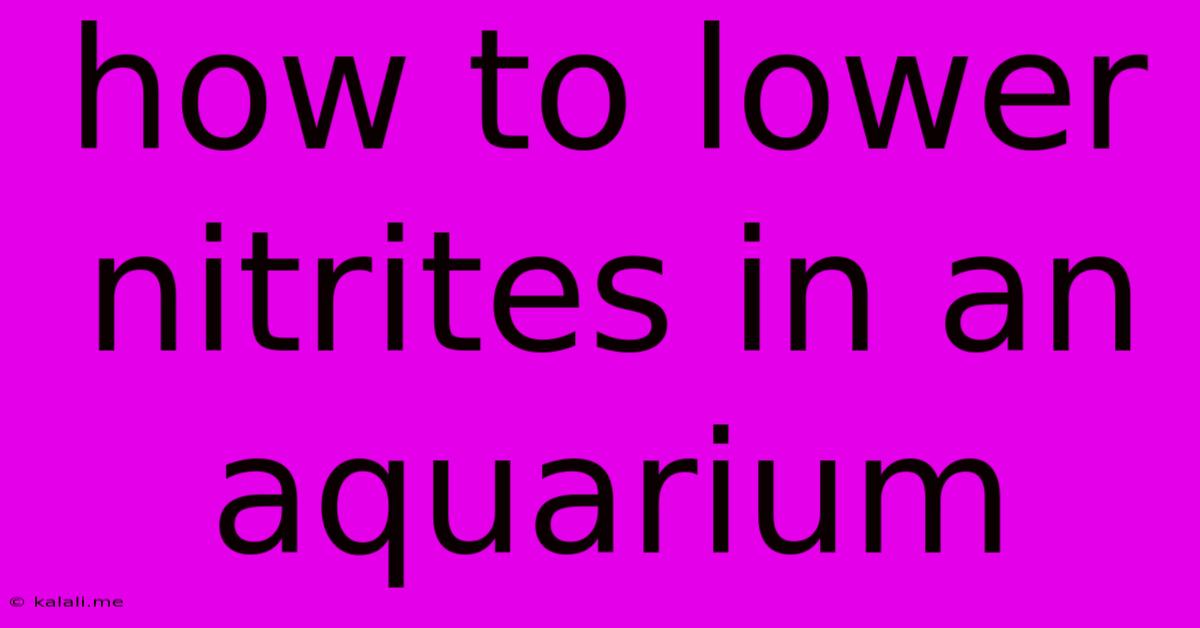How To Lower Nitrites In An Aquarium
Kalali
May 21, 2025 · 3 min read

Table of Contents
How to Lower Nitrites in Your Aquarium: A Comprehensive Guide
High nitrite levels in your aquarium are a serious problem, indicating a disruption in the nitrogen cycle and posing a significant threat to your fish's health. Nitrites are toxic to fish, causing stress, lethargy, and even death. This guide provides a comprehensive approach to identifying the cause of elevated nitrites and effectively lowering them, ensuring a healthy environment for your aquatic companions.
What are Nitrites and Why Are They Dangerous?
Nitrites are a byproduct of the nitrogen cycle, a natural process in which ammonia (toxic) is converted into nitrites (also toxic) and then finally into nitrates (less toxic). A properly established aquarium maintains this cycle, keeping nitrite levels low. However, various factors can disrupt this balance, leading to a nitrite spike. High nitrite levels interfere with your fish's ability to absorb oxygen, leading to suffocation and organ damage. Symptoms of nitrite poisoning include rapid gill movement, lethargy, loss of appetite, and gasping for air at the surface.
Identifying the Root Cause of High Nitrites:
Before tackling the problem, it's crucial to understand why your nitrite levels are elevated. Common culprits include:
- New Aquarium Setup (Nitrogen Cycle Immaturity): In a new tank, the beneficial bacteria responsible for converting ammonia and nitrites haven't yet established themselves in sufficient numbers. This is the most common reason for high nitrites.
- Overfeeding: Excess fish food decomposes, releasing ammonia and ultimately driving up nitrite levels.
- Overstocking: Too many fish produce more waste than the bacteria can handle, overwhelming the system.
- Filter Problems: A clogged or malfunctioning filter reduces the bacteria's ability to process waste effectively.
- Sudden Temperature Changes: Significant temperature fluctuations can kill off beneficial bacteria.
- Introduction of New Fish or Plants: Introducing new inhabitants can temporarily disrupt the nitrogen cycle.
- Medication: Certain aquarium medications can harm the beneficial bacteria.
Effective Strategies to Lower Nitrites:
Once you've identified the cause, you can implement the appropriate solutions:
1. Large Water Changes: This is the most immediate and effective way to reduce nitrite levels. Perform multiple large partial water changes (25-50%) daily until the nitrite levels drop significantly. Use a water conditioner to neutralize chlorine and chloramine in your tap water.
2. Improve Filtration: Clean or replace your filter media according to the manufacturer's instructions. Consider adding additional filtration if necessary, such as a sponge filter or a canister filter, to increase the surface area for beneficial bacteria colonization.
3. Reduce Feeding: Feed your fish less frequently and in smaller quantities. Observe your fish after feeding; any uneaten food should be removed promptly.
4. Decrease Bioload (If Overstocked): If you suspect overstocking, consider rehoming some fish to alleviate the burden on your filtration system.
5. Monitor Water Parameters: Regularly test your water for ammonia, nitrite, and nitrate levels. This will allow you to track your progress and make adjustments as needed. Use a reliable liquid test kit for the most accurate results.
6. Patience and Consistency: Restoring the nitrogen cycle takes time. Be patient, consistent with your water changes and adjustments, and avoid making drastic changes all at once.
7. Beneficial Bacteria Supplements: While not a replacement for proper water changes and filtration, beneficial bacteria supplements can help speed up the process of establishing or re-establishing the nitrogen cycle.
Preventing Future Nitrite Spikes:
- Proper Aquarium Cycling: Cycle your aquarium thoroughly before introducing fish.
- Regular Maintenance: Perform regular water changes, filter maintenance, and substrate cleaning.
- Appropriate Stocking Levels: Don't overcrowd your tank. Research the appropriate stocking levels for your chosen fish species and tank size.
- Responsible Feeding Practices: Feed your fish only what they can consume in a few minutes.
By understanding the nitrogen cycle, identifying the cause of high nitrites, and implementing the strategies outlined above, you can effectively lower nitrite levels in your aquarium and create a healthy and thriving environment for your fish. Remember, prevention is always better than cure!
Latest Posts
Latest Posts
-
How To Burn Tokens On Solana
May 23, 2025
-
How To Get Rid Of One Specific Color In Photoshop
May 23, 2025
-
How To Keep Your Master Code From Evaporation
May 23, 2025
-
Soql To Find Creabe Te This Last 2 Month
May 23, 2025
-
Wordpress Automatically Deactivate Plugin If Other Plugin Is Deactived
May 23, 2025
Related Post
Thank you for visiting our website which covers about How To Lower Nitrites In An Aquarium . We hope the information provided has been useful to you. Feel free to contact us if you have any questions or need further assistance. See you next time and don't miss to bookmark.